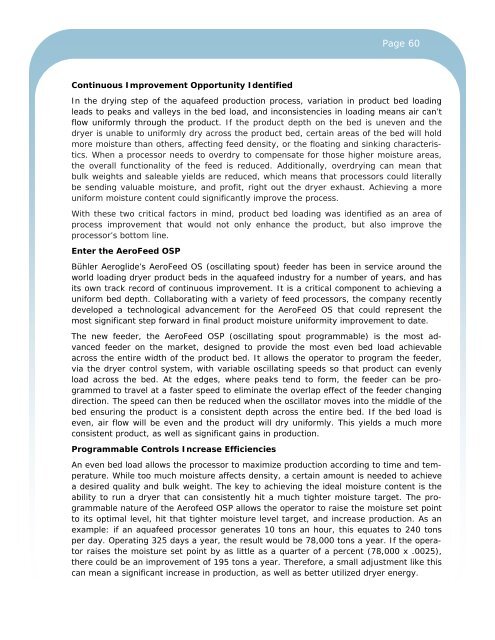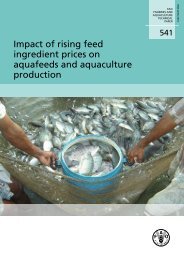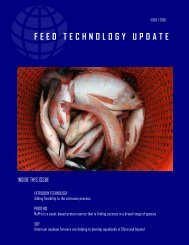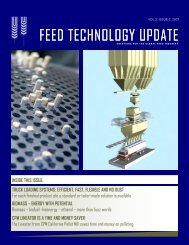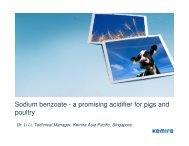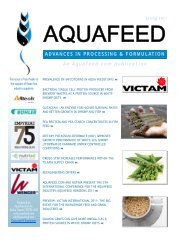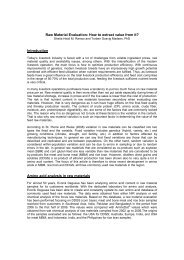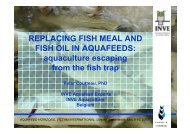Download - AquaFeed.com
Download - AquaFeed.com
Download - AquaFeed.com
- No tags were found...
Create successful ePaper yourself
Turn your PDF publications into a flip-book with our unique Google optimized e-Paper software.
Page 60Continuous Improvement Opportunity IdentifiedIn the drying step of the aquafeed production process, variation in product bed loadingleads to peaks and valleys in the bed load, and inconsistencies in loading means air can’tflow uniformly through the product. If the product depth on the bed is uneven and thedryer is unable to uniformly dry across the product bed, certain areas of the bed will holdmore moisture than others, affecting feed density, or the floating and sinking characteristics.When a processor needs to overdry to <strong>com</strong>pensate for those higher moisture areas,the overall functionality of the feed is reduced. Additionally, overdrying can mean thatbulk weights and saleable yields are reduced, which means that processors could literallybe sending valuable moisture, and profit, right out the dryer exhaust. Achieving a moreuniform moisture content could significantly improve the process.With these two critical factors in mind, product bed loading was identified as an area ofprocess improvement that would not only enhance the product, but also improve theprocessor’s bottom line.Enter the AeroFeed OSPBühler Aeroglide’s AeroFeed OS (oscillating spout) feeder has been in service around theworld loading dryer product beds in the aquafeed industry for a number of years, and hasits own track record of continuous improvement. It is a critical <strong>com</strong>ponent to achieving auniform bed depth. Collaborating with a variety of feed processors, the <strong>com</strong>pany recentlydeveloped a technological advancement for the AeroFeed OS that could represent themost significant step forward in final product moisture uniformity improvement to date.The new feeder, the AeroFeed OSP (oscillating spout programmable) is the most advancedfeeder on the market, designed to provide the most even bed load achievableacross the entire width of the product bed. It allows the operator to program the feeder,via the dryer control system, with variable oscillating speeds so that product can evenlyload across the bed. At the edges, where peaks tend to form, the feeder can be programmedto travel at a faster speed to eliminate the overlap effect of the feeder changingdirection. The speed can then be reduced when the oscillator moves into the middle of thebed ensuring the product is a consistent depth across the entire bed. If the bed load iseven, air flow will be even and the product will dry uniformly. This yields a much moreconsistent product, as well as significant gains in production.Programmable Controls Increase EfficienciesAn even bed load allows the processor to maximize production according to time and temperature.While too much moisture affects density, a certain amount is needed to achievea desired quality and bulk weight. The key to achieving the ideal moisture content is theability to run a dryer that can consistently hit a much tighter moisture target. The programmablenature of the Aerofeed OSP allows the operator to raise the moisture set pointto its optimal level, hit that tighter moisture level target, and increase production. As anexample: if an aquafeed processor generates 10 tons an hour, this equates to 240 tonsper day. Operating 325 days a year, the result would be 78,000 tons a year. If the operatorraises the moisture set point by as little as a quarter of a percent (78,000 x .0025),there could be an improvement of 195 tons a year. Therefore, a small adjustment like thiscan mean a significant increase in production, as well as better utilized dryer energy.


